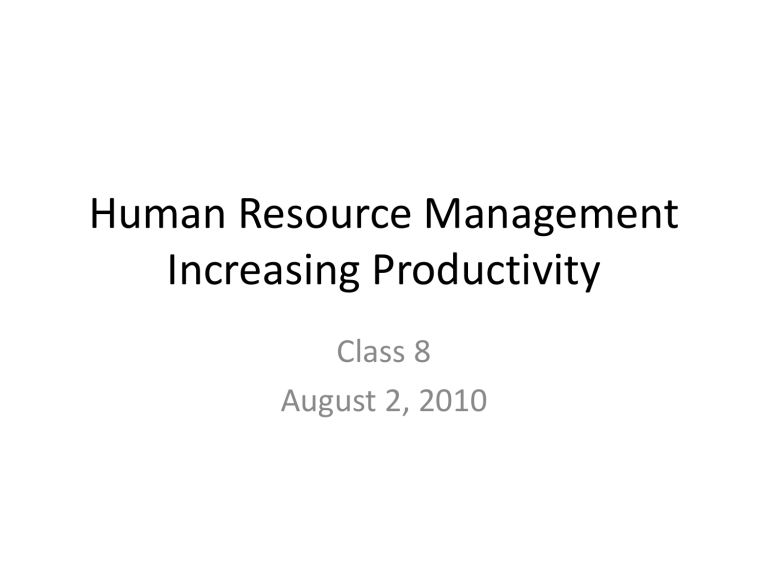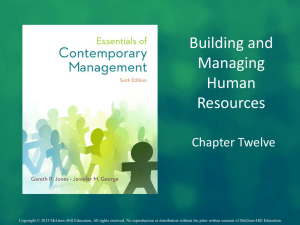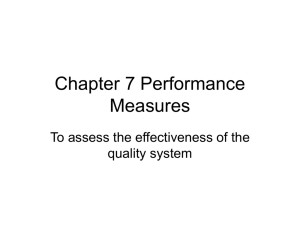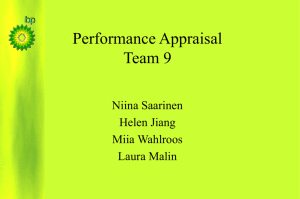HRM: Increasing Productivity - Employee Management

Human Resource Management
Increasing Productivity
Class 8
August 2, 2010
Finding and Keeping Productive
Employees
• Skilled staff is crucial for every productive human service organization
• Essential to find and hire the right perople
• Foster productivity
• Job tasks are reasonable and challenging
• Retaining good employees requires attention to work atmosphere
Developing Staff
• Job-needs analysis and person-needs analysis
• Staff performing below proficiency – staff development
• Training fits within strategy of organization
• Ensure a receptive climate from managers and unit
• Best training is OJT
• Special assignments, job rotating, cross-training
• Case method training
Organizational Structure and
Productivity
• Quality of work and interactions can be influenced by structure
• How can structure relate to function?
– No one structure fits all purposes
– Form should ALWAYS follow function
– Structure should emerge from organization’s goals and objectives
– Structure may be affected by staff composition
Structure and Productivity
• What is the best way to structure staffing patterns?
– Specializations
– Service program
– Site
– Geographical distribution of target population
Structure and Productivity
• What structural formats can be used to coordinate work of the organization?
– Bureaucratic or hierarchical format
– Market format
– Matrix format
Usually one structure is predominant, but several may coexist
Manager needs to review periodically and determine overall effectiveness
Questions for Discussion
• How is your organization structured? What is the underlying premise behind the structure?
• What does your agency do about job training?
Is it effective, in your opinion?
• Under what circumstances would you reorganize your services by function, geography, service, or matrix?
Managing Employment Challenges
• Poor performance requires manager’s attention
• Enunciate policies
• Delineate work priorities
• Structure work environments
• Match employees with job
• Make reassignments
Managing Employment Challenges
• Dealing with problem employees:
– Dead-ender
– Passed-over employee
– Technophobe
– Mismatched employee
– Work climate spoiler
*not performing to standards of the organization
*may take time and energy on manager’s part
Questions for Discussion
• A three-year, loyal and competent staff member has just returned from a 12-week family leave to care for her hospitalized child who is not is day care. As a single mother, she indicates that she is exhausted and cannot continue to carry full job responsibilities. As manager, you have the responsibility to assign large caseloads to your staff.
• How would you handle this situation?
Questions for Discussion
• There is a 55 year-old employee who has worked for your agency for 10 years; over the past several months, his work performance has begun to deteriorate. He is coming in late almost every day, is consistently behind in his reports, and a few clients have complained to you that he seems disinterested in their problems.
• As his supervisor, how would you handle the situation?
Appraising Employee Performance
• Performance appraisals accomplish several objectives:
– Connect staff performance to mission and goals
– Focus on areas requiring improvement and training
– Contribute to decisions requiring disciplinary action
– Provide feedback leading to salary increases or promotions
Appraisal Methods
• Develop a customized method to fit needs and circumstances of the organization
– Does it reflect the agency’s mission and goals?
– Does it apply quantitative or qualitative measures or both?
– What is its primary purpose?
– Are the performance standards acceptable to directors, supervisors, and staff?
– Is it likely to motivate appropriate behavior?
Types of Appraisal Methods
• Graphic Rating Scales:
– Select key characteristics related to job and overall mission and goals (e.g., initiative, job knowledge, )
– Discrete ratings: outstanding, good, acceptable, poor
– Continuum scales: 1=poor to 10=outstanding
– Disadvantage: scores are given without precise definitions; may select inappropriate characteristics; largely subjective
– Advantage: convenience and simplicity; easily scored and can be agregrated
Types of Appraisal Methods
• Behaviorally Anchored Rating Scales (BARS)
• Specifically defines behaviors along a continuum
• Example: Relationship to clients
– Excellent: always responding appropriately and being helpful to clients
– Poor: acting with hostility and rejection towards clients
The organization develops definitions for each attribute on the rating scale
BARS continued
• Outstanding: has exceptionally thorough knowledge about all facets of the job; greatly exceeds job standards
• Good: Has above average knowledge of most aspects of the job; requires only limited supervision on complex tasks; exceeds job standards
• Average: knows the necessary elements of the job to meet requirements; requires periodic supervision; meets job standards
• Poor: knowledge of job is limited; needs additional training or experience in several phases; makes frequent mistakes and requires close supervision; below job standards
Appraisal Methods
• Critical Incidents:
• Descriptions by supervisors or qualified observers of effective or ineffective behaviors
• Group rates the accounts on a scale
• Method highlights outstanding or poor performance
• Can be used to supplement other scales
Appraisal Methods
• Management by Objectives (MBO)
• Objectives and indicators used to guide staff performance and accountability
• Organization defines key results and links individual objectives
• Key result: increasing referrals for substance abuse treatment
• Staff objective: make an average of 20 referrals per month or ensure that clients connect with a referral agency 60% of the time
MBO continued
• Guidelines for performance objectives:
• Use an achievement-oriented action verb (implement, complete, carry out)
• Specify target date or time period for each objective
• State objectives that are realistic but challenging
• Include a process that enables managers and staff to mutually agree on objectives
• Set objectives that are consistent with resources available
• Align performance objectives with overall strategic plan
Qualitative Appraisal Methods
• Use of Narrative
• Narratives provide a more rounded assessment
• What has the employee do to improve performance since the last evaluation?
• What performance areas should receive special attention in the coming review period?
• What can the employee do to strengthen job performance?
• What are the employees career goasl?
• What additional training is needed?
Conducting an Appraisal Conference
• Connect the employees work to unit objectives and overall agencymission and goals
• Determine desired outcomes of the meeting in advance
• Foster mutual problem solving
• Ask questions to encourage staff input
• Supervisor and staff develop action plan with clear objectives and plans for follow-up
Pitfalls Impact Appraisal Process
• Tendency to focus on most recent performance
• “halo effect”
• “Average tendency”
• “Forced-choice tendency”
• “Inflation tendency”
Provide meaningful feedback that is clear and descriptive
Provide concrete examples to illustrate concerns
Questions for Discussion
• What type of appraisal method would work best for your organization?
• What would be the best method for conducting an appraisal conference in your organization?






